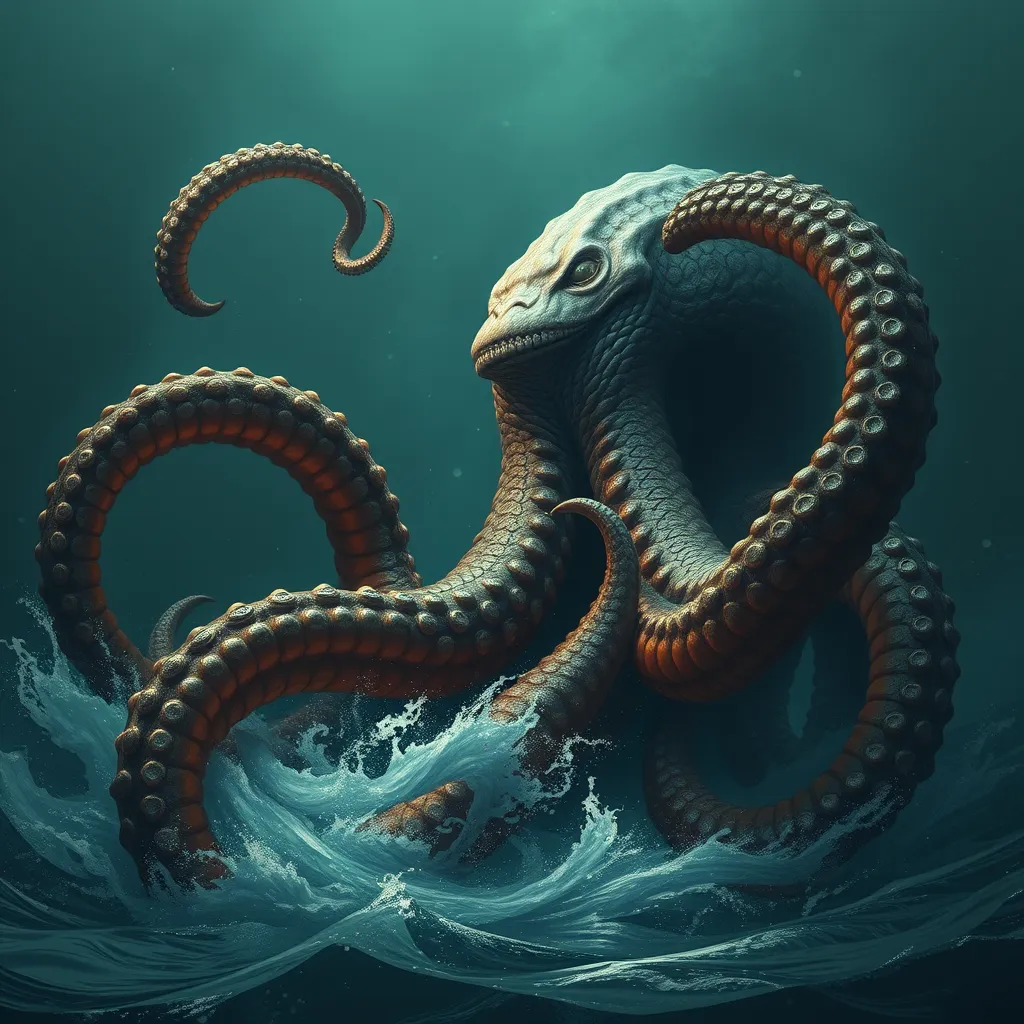The Kraken’s Behavior: Understanding the Monster’s Habits, Motivations, and Interactions
I. Introduction
The Kraken, a legendary sea monster, has captured the imaginations of people for centuries. Often depicted as a gigantic octopus or squid, the Kraken has been a staple in mythology and popular culture, representing the vast mysteries of the ocean. Its tales speak of ships being dragged to the depths, leaving sailors in terror and wonder. As we delve into the behaviors and interactions of this mythical creature, we gain deeper insights into maritime lore and human fears of the unknown.
Understanding the Kraken’s behavior not only enriches our appreciation for these tales but also sheds light on how human perceptions of nature have evolved. This article aims to explore the historical context, behavioral patterns, motivations, and ecological significance of the Kraken, as well as its modern representations in media and culture.
II. Historical Context of the Kraken
A. Origins of the Kraken myth in Scandinavian folklore
The Kraken’s origins can be traced back to Scandinavian folklore, where it was often described as a fearsome creature lurking off the coasts of Norway and Greenland. Sailors recounted stories of a massive sea monster that would rise from the depths, ensnaring ships in its tentacles. These tales likely stemmed from encounters with real marine animals, such as giant squids, which inspired exaggerated accounts of their size and ferocity.
B. Evolution of the Kraken’s image over time
Over the centuries, the Kraken’s image has evolved significantly. Initially portrayed as a terrifying beast, it gradually transformed into a more complex character in literature and art. The Romantic period, in particular, saw the Kraken depicted as a symbol of nature’s sublime power, embodying both beauty and terror.
C. The Kraken in literature and film
The Kraken has made its mark in literature, appearing in works such as Alfred Lord Tennyson’s poem “The Kraken,” which emphasizes its mysterious and majestic nature. In modern cinema, the Kraken has often been featured in films like “Pirates of the Caribbean: Dead Man’s Chest,” where it serves as a formidable antagonist. This evolution reflects changing societal attitudes toward nature and the ocean, from fear to fascination.
III. Behavioral Patterns of the Kraken
A. Feeding habits and diet
While the Kraken is a mythical creature, its feeding habits can be imagined based on real-life cephalopods. Typically, a creature of such size would likely have a varied diet, including:
- Fish
- Crustaceans
- Other large marine animals
The Kraken may have been envisioned as an apex predator, capable of consuming anything in its path, reflecting the fears of sailors encountering the unknown.
B. Hunting techniques and prey selection
In folklore, the Kraken was often depicted as using its massive tentacles to ensnare its prey. This method of hunting would be efficient for a creature of its size, allowing it to ambush unsuspecting fish or even ships. The idea of the Kraken lurking beneath the surface, waiting for the perfect moment to strike, emphasizes the unpredictability of the ocean.
C. Seasonal and environmental influences on behavior
The Kraken’s behavior could also be imagined as influenced by environmental factors, such as:
- Seasonal migrations of prey
- Changes in water temperature
- Ocean currents and tides
These factors could lead the Kraken to alter its hunting patterns, enhancing its mythical portrayal as a creature deeply connected to the ocean’s rhythms.
IV. Motivations Behind the Kraken’s Actions
A. Survival instincts and territoriality
The Kraken, like any apex predator, would be motivated by survival instincts. Legends often depict it as fiercely territorial, challenging other sea creatures or even humans that encroach on its domain. This aspect adds to its fearsome reputation and highlights the primal fears humans have about the ocean’s depths.
B. Reproductive behaviors and mating rituals
Imagining the Kraken’s reproductive behaviors could involve elaborate mating rituals, akin to those of real squids and octopuses. These behaviors might include:
- Color changes to attract mates
- Complex courtship displays
- Territorial displays to ward off rivals
Such behaviors would emphasize the Kraken’s role in the marine ecosystem and its connection to the cycle of life.
C. Influence of human activity on the Kraken’s motivations
In contemporary interpretations, the Kraken’s motivations could also be influenced by human activities, such as fishing, pollution, and climate change. These factors might drive the creature further into the depths or provoke more aggressive behavior as it reacts to the encroachments of humanity.
V. Interactions with Other Marine Creatures
A. Predator-prey relationships
The Kraken’s interactions with other marine creatures would predominantly be characterized by predator-prey dynamics. It could be seen as the ultimate predator, instilling fear in smaller marine life and maintaining ecological balance in its mythical ecosystem.
B. Symbiotic interactions with other species
While often depicted as a solitary creature, the Kraken could engage in symbiotic relationships with other species, such as:
- Cleaner fish that help maintain its health
- Small marine animals that seek refuge among its tentacles
These interactions would add depth to the Kraken’s character, showing that even the most fearsome creatures can have complex relationships within their ecosystems.
C. Impact of environmental changes on these interactions
Environmental changes, such as rising sea temperatures or pollution, would likely impact the Kraken’s interactions with other marine life. A shift in the ecosystem could lead to altered prey availability, forcing the Kraken to adapt its hunting strategies or face decline.
VI. The Kraken’s Role in Maritime Ecosystems
A. Ecological significance of the Kraken in mythological contexts
In mythology, the Kraken serves as a symbol of the ocean’s vastness and mystery. Its presence in folklore highlights the importance of the sea within human culture, representing both danger and allure.
B. The Kraken as a symbol of the unknown depths of the ocean
The Kraken embodies humanity’s fascination with the unknown. It symbolizes the fears and wonders of exploring the deep sea, a realm that remains largely uncharted and mysterious to this day.
C. Implications for modern marine biology and conservation
In modern marine biology, the Kraken’s mythological significance can inspire conservation efforts. By understanding the importance of preserving marine ecosystems, we can draw parallels to the lessons taught by the tales of the Kraken and the need to protect our oceans.
VII. Modern Interpretations and Representations
A. The Kraken in contemporary media and art
Today, the Kraken continues to inspire artists, filmmakers, and writers. Its portrayal in contemporary media often reflects societal fears about the unknown, climate change, and the consequences of human actions on the environment.
B. Psychological and cultural implications of the Kraken myth
The Kraken serves as a psychological representation of humanity’s fears about the ocean and the unknown. It reflects deep-seated anxieties about nature’s power and our vulnerability in the face of it.
C. The impact of the Kraken on tourism and local economies
The Kraken has also become a tourist attraction in various coastal regions, contributing to local economies. Festivals, merchandise, and themed attractions capitalize on the allure of this mythical creature, drawing visitors eager to explore the legends surrounding it.
VIII. Conclusion
In summary, the Kraken’s behavior, motivations, and interactions reveal much about human perceptions of the ocean and the mysteries it holds. Through the lens of this mythical creature, we can explore themes of survival, ecological balance, and the impact of human activity on marine life. The enduring legacy of the Kraken in culture serves as a reminder of our connection to the sea and the importance of understanding and preserving it.
Future research into mythological studies can deepen our comprehension of how such legends shape our views of nature and inspire conservation efforts. As we




